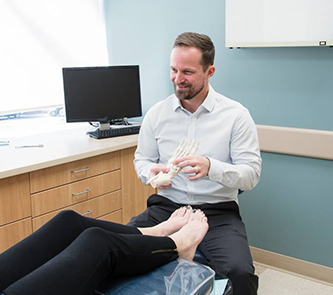Frequently Asked Questions
Over the years, we’ve gotten a lot of questions from our patients—including some very unique ones! We always try to answer each as best we can.
Of course, some questions are asked a lot more frequently than others. That’s what this page is for! Hardly a day goes by where we don’t answer at least a handful of the questions below. If you’re currently dealing with heel pain, bunions, or a recent injury, you just might find the answer you’re looking for on this page!
Of course, not even the most comprehensive FAQ page is a substitute for a professional evaluation, so be sure to give us a call if you’re experiencing any kind of foot or ankle issue that you aren’t able to handle on your own. We are here to help!
Why does the bottom of my heel hurt, especially in the morning or after periods of rest?
Although we’d want to make a full examination before confirming a diagnosis, this is a classic symptom of plantar fasciitis. In this condition, the band of tissue that supports your arch, called the plantar fascia, becomes overstretched and inflamed near the connection point with the heel bone.
During periods of rest (such as overnight), the fascia contracts and the tissue attempts to heal itself. The next morning, as you set your foot on the floor, the fascia suddenly has to stretch out again and some of the repair work is undone. Often, this means pain is at its worst in the early morning or when rising from a long sit, but gradually subsides (at least partially) as the fascia continues to stretch out.
Why does it feel like I’m walking on a pebble?
If the “pebble” is located in the ball of your foot, between either the second and third or third and fourth toes, the most likely explanation is a Morton’s neuroma.
The neuroma is actually a thickened mass of tissue that can develop near a nerve in the ball of the foot. The mass itself is not painful or cancerous, but it can cause painful symptoms if it’s positioned so that it presses on the nerve when you stand or walk.
Conservative treatments can often relieve the pain of a neuroma. In more severe cases, the nerve may need to be decompressed or removed surgically.
Can I treat my ingrown toenail at home?
Although it is possible to treat a mild ingrown toenail at home in some cases, we generally do not recommend this. Professional treatment will get you fast, effective results with minimal pain and much lower risk of infection than managing care on your own at home.
If you do attempt to treat ingrown toenails at home, never attempt to cut or dig out the nail on your own. Simply soak your feet in warm water with Epsom salt for 15 minutes, 3-4 times per day, then apply antibiotic ointment and loosely bandage (with a fresh bandage after every soak).
Never attempt home treatment if you have diabetes, poor circulation, or are immunocompromised in any way. Discontinue home treatment and call us immediately if your ingrown toenail is severely painful or shows any other signs of infection (swelling, red streaks, drainage, etc.)
I think I broke my foot/toe. What do I do?
If you suspect a fracture, take weight off the area and begin RICE therapy immediately as first aid:
- Rest—avoid activity that would put weight on or aggravate the injury.
- Ice—use ice packs as necessary for up to 20 minutes at a time to manage pain and swelling.
- Compression—Use a compression wrap (such as an ACE bandage) around the injured area, if you know how and feel comfortable using them.
- Elevate—keep the injured foot elevated, ideally above heart level, as much as possible (including while you sleep).
You should also call our office as soon as possible to schedule an appointment. Even “minor” breaks are serious injuries, and if you don’t get proper care in a timely fashion you can end up doing more severe, long-lasting damage. We will make every effort to see you as soon as possible, or tell you if you need to seek out urgent care.
Why is there a bump on the back of my heel?
If you’ve noticed a bump on the back of your heel, the most likely explanation (although certainly not the only possible diagnosis) is Achilles tendinitis.
Achilles tendinitis is typically the result of chronic, repetitive strain on the Achilles tendon that eventually causes the tendon fibers to tear or degenerate. This leads to thickening and swelling in the tendon, which often produces a noticeable “bump” along the back of the heel that may be extremely tender when pressed.
Often, the first sign of Achilles tendinitis is mild aching in the back of the tendon, above the heel, especially after periods of activity. However, as the condition worsens you may start to feel more severe pain, swelling, tenderness, and stiffness that doesn’t always go away with rest. Eventually, the tendon may completely rupture, so it’s critical you get the care you need sooner rather than later.
Another possible explanation for a bump at the back of the heel is Haglund’s deformity. This condition is thought to be a natural reaction to extended irritation and inflammation in the bursa sac located along the back of your heel. Your body attempts to deal with the trauma by leaving bony deposits on the end of the heel bone, creating a very hard bump that can cause further discomfort. If you regularly wear hard-backed footwear, such as pumps or ice skates, you may be more likely to develop Haglund’s deformity.
I sprained my ankle. What can I do?
Ankle sprains should always be taken very seriously, even supposedly mild ones. While it is true that many sprains can be treated at home, you still need to be very disciplined about the way you care for your injury. Sprains that aren’t given the chance to heal properly can result in ongoing pain, weakness, and instability in the joint—often leading to additional sprains down the road.
If you suspect a sprain, discontinue your activity, limit putting weight on the affected ankle if it is painful to do so, and begin RICE therapy immediately:
- Rest—avoid activity that would put weight on or aggravate the injury.
- Ice—use ice packs as necessary for up to 20 minutes at a time to manage pain and swelling.
- Compression—Use a compression wrap (such as an ACE bandage) around the ankle, if you know how and feel comfortable using them. Don’t wrap too tight, as this can hinder circulation.
- Elevate—keep the injured foot elevated, ideally above heart level, as much as possible (including while you sleep).
Check out this helpful video for a more detailed guide on RICE therapy for an ankle sprain:
You should also give our office a call, especially if you’re dealing with severe pain or inability to put weight on the foot. We can help you determine whether it’s a good idea to come in for a closer evaluation, or if you can continue for the time being with home care.
Do I need to have bunion surgery?
Not all bunions require surgery!
While it is true that surgery is the only way to remove a bunion and realign a toe that has already begun drifting, this is not necessarily the primary goal of treatment. We’re more concerned about whether you can wear normal shoes, perform daily tasks, and enjoy your favorite hobbies without pain. If conservative treatments (such as shoe modifications, orthotics, protective padding, toe exercises, etc.) can do this for you, then we can put surgery on indefinite hold.
Usually, surgery is only recommended if:
- Your bunion is causing daily pain and/or keeping you from engaging in activities that are important to you.
- You have exhausted any non-surgical remedies that might have been sufficient, leaving surgery as your last or best option.
Despite the fact that we see surgery as a last resort, we are happy to say that the procedure is extremely successful on average, with the vast majority of patients very satisfied with long-term results.
Is bunion surgery painful?
There should be minimal if any pain during the procedure itself, as anesthetic is used. Post-surgical discomfort and swelling tends to be the most acute for about two to five days after surgery, but most people are able to tolerate it well.
We also often recommend the use of MLS laser therapy in post-operative recovery. This technology can substantially reduce the amount of post-surgical pain and swelling you experience, often drastically reducing (if not eliminating) your need for narcotics after surgery. It will also help you heal faster.
My nail is thick and discolored. What can I do?
Thickened, discolored nails are usually (although not always) the result of a fungal infection under the nail. However, we may need to take a biopsy of the nail to be sure.
Unfortunately, fungal toenail infections do not go away on their own, and home care treatments are almost completely ineffective. Even worse, the fungi can spread (often via your shoes) to other nails, or to your skin. (The same fungi that cause fungal toenails also cause athlete’s foot, among other infections.)
If you want your healthy nails back, there are several professional treatment options available. At Northeast Foot and Ankle, we offer a variety of treatment option including topical or oral medications and laser therapy.
Pay Your Bill
Make a payment online through our payment portal or Care Credit!
Portsmouth Office
14 Manchester Square, Suite 250
Portsmouth, NH 03801
Nashua Office
17 Riverside Street, Suite 205
Nashua, NH 03062
Website Hosted by SC Digital



